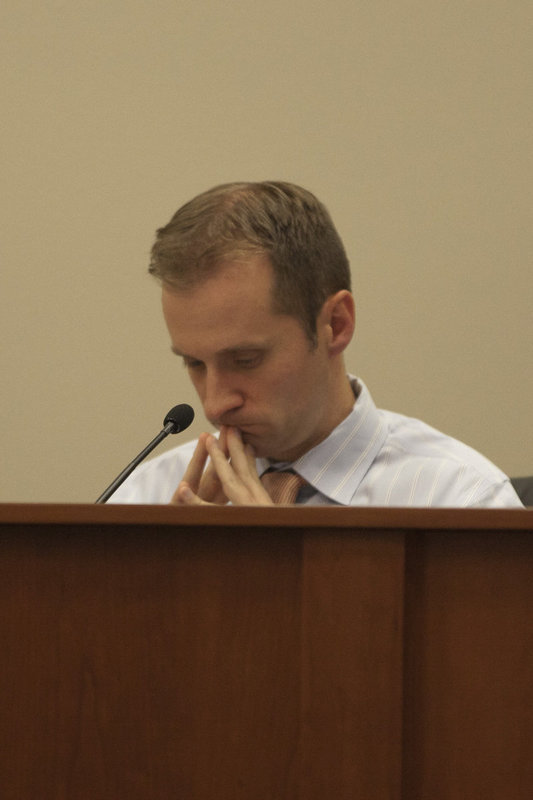Cache County School Board holds building and bond meeting
Board Member Jonathan Jenkins looks over the building and bond report presented at last nights meeting. (Corey Burger)
After taking care of some routine business the Cache County School Board discussed how negotiations had gone with the classified employee association, and the teachers association this year. That was followed up with presentations on the progress of a facilities assessment report and a status update on the Adequate Yearly Progress Report (AYP).
Kirk McRae began the meeting by taking care of a few agenda items by presenting a request for the board to approve an immediate retirement request by Roberta Black. Once that motion was approved McRae discussed how the negotiations between the district and the Classified Employees Association and the Teachers Association had taken place.
Detailing the negotiation process this year with both associations McRae outlined some of the details of agreements reached during the recent negotiations. Classified employees like many other state and city employees will not see a cost of living increase this year, and will face a reduction to some of their benefits, with an increase in health insurance costs. A slight surplus in one district fund will allow the increase to be offset by 2% bringing the anticipated increase in health insurance cost to the employees down from 12% to 10% for the coming year.
Some good news came from the negotiations those employees on a step track should be able to expect an increase if they would qualify for one this year.
The district was able to solidify the future costs of early retirement buyout for employees that qualify with at least twenty eight years of service. Twenty of those years must be in the district and they must be within two years of retiring. McRae indicated that over the past few years costs to buy out early retirement years have increased by twenty to thirty percent. A benchmark chart will be used to determine what the portion of the annual cost to purchase the early retirement would be for the district. Additional costs associated with current and future early retirement buyout would be the responsibility of the employee. The benchmark chart that will be used to determine these costs was created by the state three years ago.
The negotiations with the Teachers Association went pretty much the same as those with the Classified Employees Association related to step funding, insurance, and retirement. However, changes were discussed related to any future situations that would require a reduction of force. Per a new state mandate all references to seniority have been removed from the current district policy. There will be two criteria used from this point forward if situations in the district require a reduction of force. First will be the performance evaluation score given to the employee. The second consideration will be the degree or rating associated with the teacher. Teachers are currently put into five lanes that will be used to help determine who would be kept and who would be let go if a reduction of force were implemented. Those tracks are those with a bachelor’s degree, those with a bachelor’s degree plus thirty or more semester hours with the district, those with a master’s degree, those with a master’s degree plus forty or more semester hours with the district, and those with a doctorate degree. Also a consideration for these groups will be teaches with ESL certifications and the like. Those with a higher degree and more semester hours would be given preference over those with lesser degrees and time with the district if a reduction in force took place. In the event of a tie in evaluation scores, degrees and semester hours the district would draw lots to see who would be let go.
McRae expressed his appreciation for the two associations and the professionalism that each group displayed in the negotiation process this year. McRae stated, “the negotiation process was made up of cooperative and productive discussions with both groups, they understand we are going through some tough times.” All negotiations have been ratified by both associations
Following McRae’s detailing of the negotiation process Superintendent Steve Norton discussed the Bond Committee Report detailing the process that took place in 1996 by a committee chaired by Richard Maughn. The committee was tasked with getting a report of when each building in the district was built and recommending future planning for the district. That committee recommendation resulted in a $36 Million new high school plan, a new middle school plan option, or voters could do nothing at all. In 2003 a new bond election committee this time chaired by Terri Chase Dunn, once again took a look at the district’s needs. This committee requested reports from each school in the district as to their building and equipment needs. Based on the recommendations of the committee an election was held and $60 Million was approved for the board to use throughout the district. Norton said that periodic reports have been put out that explain what has been done with that fund, and that it was time for a new report to update the public on what the district has done with that fund and how it correlates with the plans and priorities established by the various committees.
Based on Norton’s recommendation for the preparation of a new report board member Jonathan Jenkins recommended looking at current borrowing limits, what existing debt is out there and what debts will be retired soon to make more educated decisions and be able to create the current report.
Bruce Parker reported on the districts efforts to meet with and interview several firms in order to narrow down candidates that could come in and do an evaluation on the current status of the districts building needs. A national architectural firm Fanning Howey, with new offices in Utah, rose to the top of the firms interviewed. Chosen for their ability to come in and assess what is referred to as the physical adequacy of the buildings in the district, but also can assist with evaluating and working with administration to determine the educational adequacy of the districts buildings. The firm is also capable of helping with master planning needs of the district. Seismic codes for wood framed buildings were established in 1976, while codes for masonry buildings which make up the bulk of the districts buildings were established in 1997. The district intends to have Fanning Howey look at all buildings in the district built before those dates and evaluate what needs and costs will be associated with bringing buildings up to code.
Parker mentioned having been on some of the previous committees, having one firm trained in this type of work perform several of the various evaluations could bring consistency into the final recommendations that may have been lacking in the past. The intention is for the board to look at the recommendations and see if it is more financially sound to do upgrades and repairs to older buildings or to walk away from them and look at putting that money into new structures. Of great concern to the district are schools in Lewiston and Wellsville along with a few other schools in the district that far pre-date the codes and may not be cost effective to upgrade. The board will look over Parker’s presentation and recommendation and decide how to go forward. Items they will discuss will be what district buildings to add or remove from Parker’s list and which of the evaluations should take place on the individual buildings. Speaking of the preliminary figure of $163,417 to have Fanning Hower perform the evaluations, Parker stated, “I think it is a good, fair fee.” Current bonds are in place that can be used to pay for the evaluations.
The Obama administration is going forward with provisions that allow states “willing to embrace educational reform,” to opt out of key provisions of the No Child Left Behind (NCLB) federal education law. Presenting this report from ED.gov, Blake Pickett reported to the board that they feel this is a positive move and will benefit the district. Cache County School District (CCSD) has high marks in the various fields tested to see student’s progress and appropriate levels of knowledge are at acceptable levels. Adequate yearly progress (AYP) reports show that CCSD in grades 3-8 as well as 10-12 are all at or above expectations and as a whole look good. However, the NCLB law singles out individual groups within those areas and a school or district could be marked down for poorer performance in one group of about forty groups that are evaluated under NCLB laws. Some areas where lower scores may be found are in groups where students may have a language barrier where English is not their first language, or for instance economically challenged groups.
Each year students are evaluated using Criterion-Referenced Tests (CRT), where they are evaluated against a standard rather than against each other. Using a professional learning community model teachers look at where kids are learning and where they are not. These evaluations coupled with Utah Performance Assessment System for Students (U-PASS) allows for good collaboration with teachers to assess needs, and look at progress by teachers and students from one year to the next according to Pickett.
In closing the meeting Superintendent Norton expressed deep and heartfelt appreciation for the faculty and employees of the district. Norton citing recent state and federal mandates to update the standards associated in the common core curriculum said, “This building has been jam packed with faculty here training their people. When we have the funds available to add back in professional development days it needs to be a priority of the board, so we can compensate these dedicated teachers.” Brian Lieshman echoed Norton’s sentiment stating recommending the use of the internet and guest editorials to let the public know about the dedication, and devotion of the high quality teachers and employees within the district.

